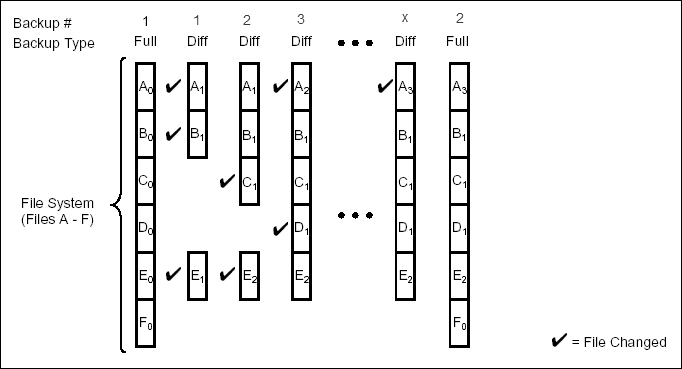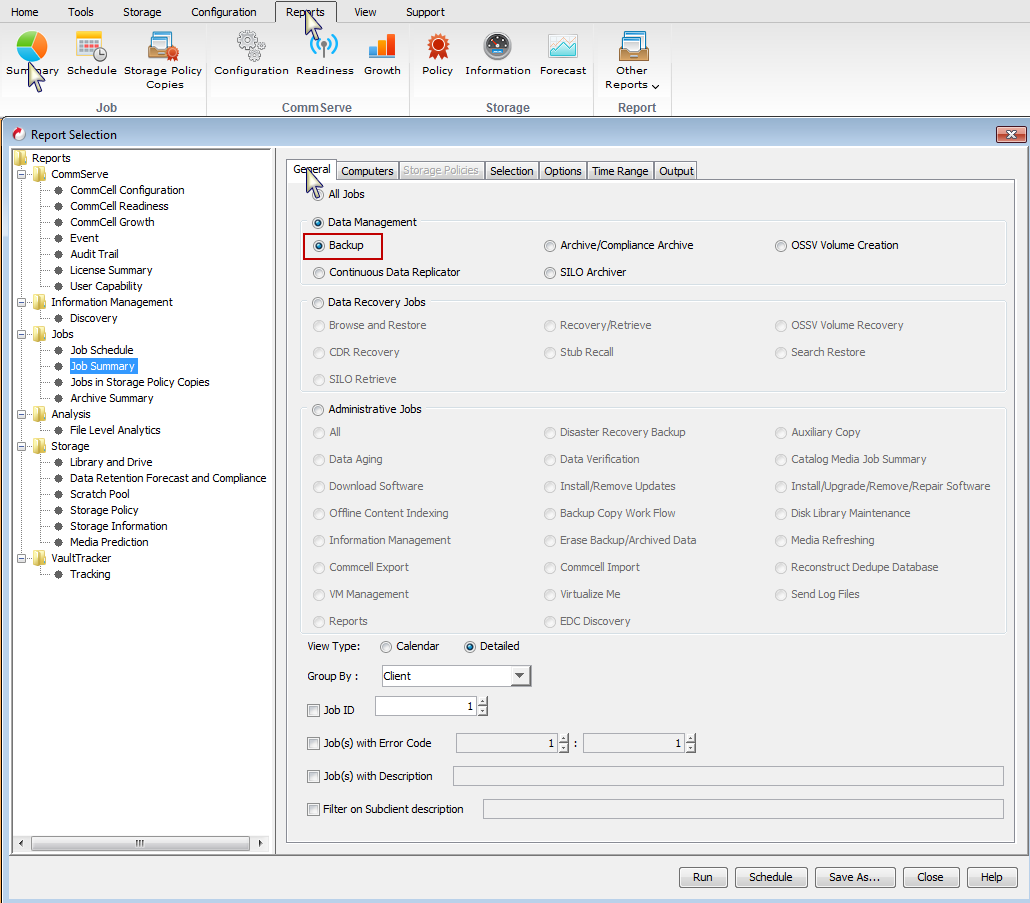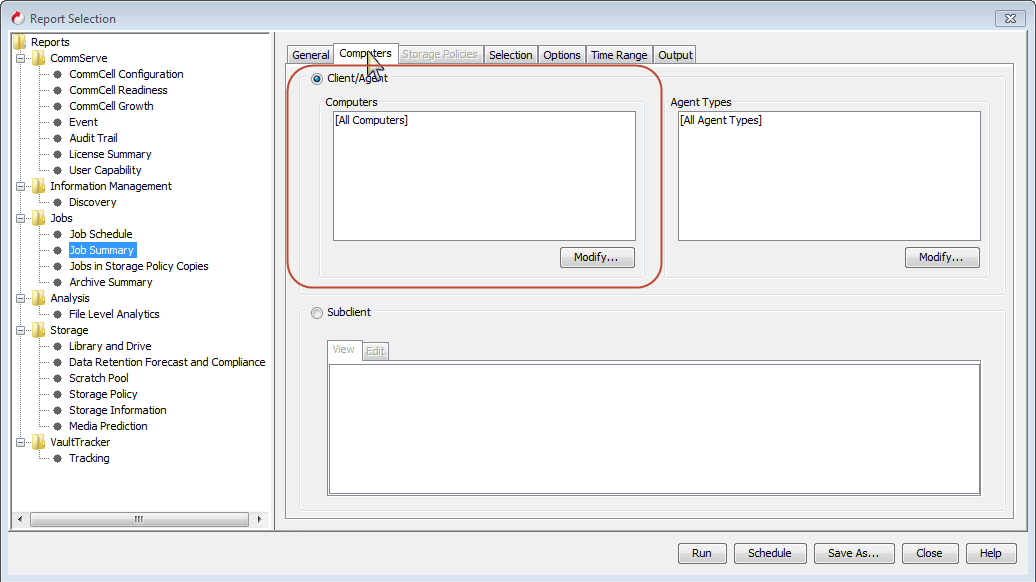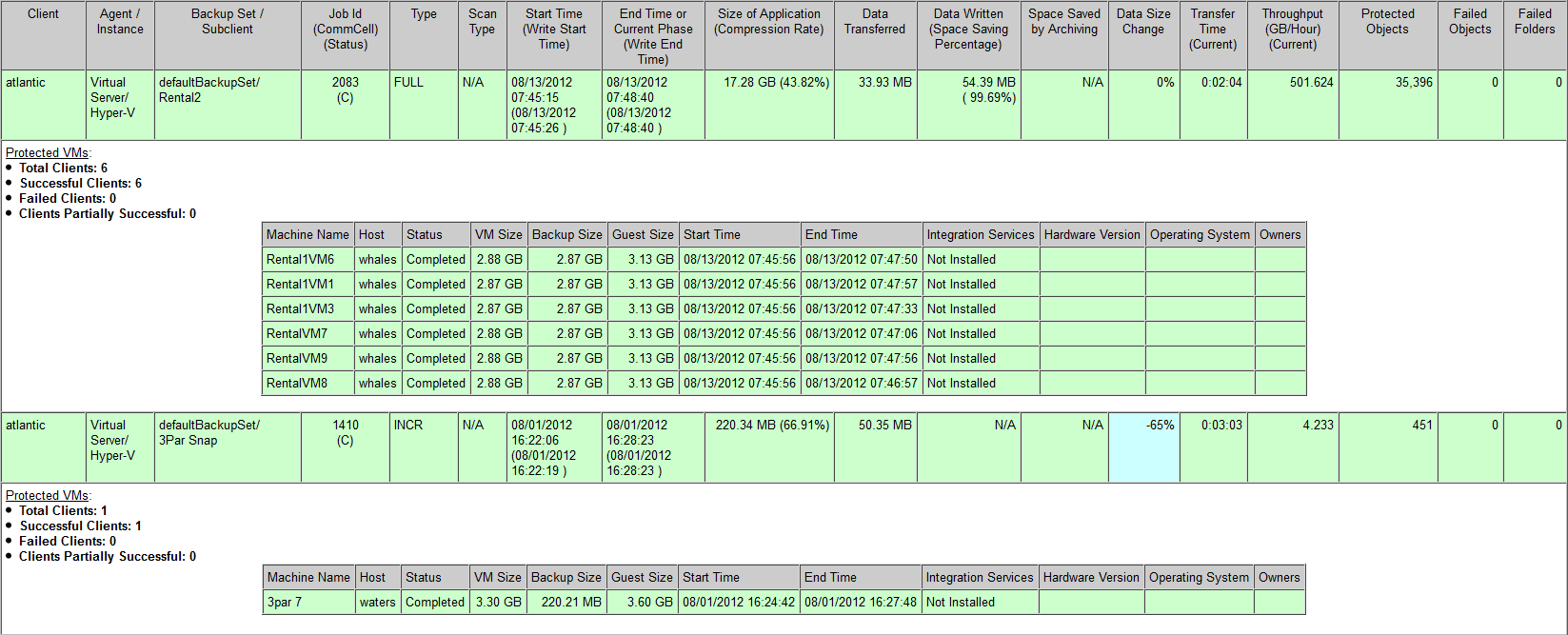What Gets Backed Up
-
Virtual machines (powered on or powered off)
-
VHD/VHDX files
-
Snapshot files
-
Configuration files for virtual machines
-
Metadata required for granular recovery of files (NTFS and ext3 volumes only)
-
VHDX formatted hard disks with sector size of 4K bytes without metadata.
What Does Not Get Backed Up
-
Pass-through disks
-
Windows Storage Spaces
-
Hard links (only for disk-level backup)
-
Virtual machine smart paging files
-
Certain virtual machines in which Volume Shadow Copy Service (VSS) fails to create a shadow
-
Devices residing in a guest virtual machine over iSCSI or vHBA
-
Shared VHDX files.
-
VM folders with compression enabled
When a virtual machine resides on a VM folder that has compression enabled, backups of that virtual machine fail. However, manual snapshots of the virtual machine complete.
Limitations
The following limitations apply to Microsoft Windows Server 2016 and more recent versions:
-
When granular metadata collection is enabled for IntelliSnap backup operations, the proxy host designated for the IntelliSnap backup operations cannot be a member of the cluster nodes where the source VM resides.
To correctly designate the proxy host (MediaAgent) for this scenario, follow these steps:
-
From the CommCell Browser, go to Client Computers > Virtualization Client > Virtual Server > Instance > DefaultBackupSet.
-
Right-click the default subclient, and then click Properties.
The Subclient Properties dialog box appears.
-
On the IntelliSnap Operations tab, from the Use Proxy list, select the MediaAgent.
-
-
Because of a Microsoft limitation, you cannot implement Disk Signature changes.
Full Backup
Full backups provide the most comprehensive protection of data. However, full backups also consume the most amount of time and resources.
Procedure
-
From the CommCell Console, navigate to Client Computers > virtualization_client > Virtual Server > Hyper-V > defaultBackupSet.
-
Right-click the <Subclient> and click Backup.
-
Select Full as backup type and Immediate to run the job immediately.
Click OK.
-
You can track the progress of the job from the Job Controller or Event Viewer window.
-
Once job is complete, view the details of job from the Job History.
Right-click the <Subclient>, click View and then click Job History.
-
Click OK.
-
You can view the following details about the job by right-clicking the job:
-
Items that succeeded during the job
-
Items that failed during the job
-
Details of the job
-
Media associated with the job
-
Events of the job
-
Log files of the job.
-
Incremental Backups
An incremental backup contains only data that is new or has changed since the last backup, regardless of the type. On average, incremental backups consume far less media and place less of a burden on resources than full backups.
The illustration on the right clarifies the nature of full and incremental backups. For simplicity, assume there is a file system that contains six files as represented in the figure.
Backup #1 is a full backup and therefore writes all the data, changed and unchanged, to the backup media. Backups #2 through #n-1 are incrementals and only back up those files that have changed since the time of the last backup, regardless of the type. For example, files A, B, and E changed after the full backup and were therefore backed up in Backup #2. Backup #4 backed up files A and D because both files were modified sometime after Backup #3 occurred. File F did not change; hence, it was not backed up in any of the incremental backups, but it was included in both full backups, which, by definition, back up everything.

-
From the CommCell Console, navigate to Client Computers | < Hyper-V Client> | Virtual Server| Hyper-V | <BackupSet>.
-
Right-click the <Subclient> and click Backup.
-
Right click the subclient and click Backup.
-
Select Incremental as the Backup Type.
-
Select Immediate as the Job Initiation option.
-
Click OK.
You can track the progress of the backup job from the Job Controller window.
When the backup has completed, the Job Controller displays Completed.
Differential Backups
A differential backup contains only the data that is new or has changed since the last full backup. Like incremental backups, differential backups, on average, consume less media and place less of a burden on resources than full backups. Differential backups are cumulative. This means that each differential backup contains all changes accumulated since the last full backup. Each successive differential backup contains all the changes from the previous differential backup.
The illustration on the right demonstrates the nature of differential backups. For simplicity, assume there is a file system that contains six files as represented in the figure.
Backup #1 is a full backup and therefore writes all the data to the backup media. Backups #2 through #n-1 are differential backups and only back up those files that changed since the time of the last full backup. For example, files A, B, and E changed after the full backup and were therefore backed up in Backup #2 as well as all subsequent differential backups. File C changed sometime after Backup #2 and was consequently backed up in Backup #3 and all subsequent differential backups. File F did not change; hence, it was not backed up in any of the differential backups, but it was included in both full backups, which, by definition, back up everything.

-
From the CommCell Console, navigate to Client Computers | <Microsoft Hyper-V Client> | Virtual Server| Hyper-V | <BackupSet>.
-
Right-click the <Subclient> and click Backup.
-
Right click the subclient and click Backup.
-
From the Backup Options dialog box, select from the following options:
Backup Type:
- Select Differential.
Backup Schedule:
- Select Run Immediately
-
Click OK.
-
You can track the progress of the backup job from the Job Controller window.
-
When the backup has completed, the Job Controller displays Completed.
Synthetic Full Backups
A synthetic full backup is a synthesized backup, created from the most recent full backup and subsequent incremental or differential backups. The resulting synthetic full backup is identical to a full backup for the subclient.
Unlike full, incremental, and differential backups, a synthetic full backup does not actually transfer data from a client computer to the backup media and does not use any resources on the client computer.
Synthetic full backups are media-based; they read backup data from one media and simultaneously write (restore) the result to the new active media within the same media group. As a result, synthetic full backups require that at least two media drives for the same storage policy be available at the time the job is started. Synthetic full backups cannot be performed on subclients where the storage policy is associated with a stand-alone drive.
If any IntelliSnap backups have not yet been backup copied, a synthetic full backup job fails. Synthetic full backups cannot run on snap copies.
Note: For Forever Incremental backups with the Virtual Server Agent, create a separate Snapshot copy on the storage policy and specify a data aging rule that includes the Retain Snaps by Number of Jobs option with a number of jobs that matches your backup cycle. This ensures that the previous backup jobs are pruned on a regular basis. For more information, see Data Aging for IntelliSnap Snapshots.
Accelerated Synthetic Full Backups (DASH Full)
When a storage policy copy is deduplicated, synthetic full backups can be created in an accelerated mode to significantly reduce the copy duration. This is done by identifying and transferring the data signatures (instead of the data itself) to the target wherever possible.
Running Backup Copy for a Subclient
Before you Begin
-
For a VSA subclient, the IntelliSnap option must be enabled on the IntelliSnap Operations tab; otherwise the Run Backup Copy option is not available on the subclient. For more information, see Enabling IntelliSnap.
-
If the CommServe system is running Commvault Version 11 Service Pack 5 or later, but the virtualization client is running Version 10, this feature must be enabled.
Procedure
Before a synthetic full backup can be run for a subclient, any jobs that should be included in the synthetic full backup must be moved to the backup copy media. You can use this option if a synthetic full backup fails because required backup copies are still pending.
-
From the CommCell Console, navigate to Client Computers > virtualization_client > Virtual Server > Hyper-V > backup_set.
-
Right-click the subclient and click Run Backup Copy.
Running Synthetic Full Backups
Before You Begin
-
Ensure that any incremental or differential backups have been written to tape by performing the task in Running Backup Copy for a Subclient.
-
For the storage policy associated with the synthetic full job, IntelliSnap jobs that should not be included in the synthetic full backup should not be picked for backup copy as described in Disable a Job for Backup Copy.
-
If the CommServe system is running Commvault Version 11 Service Pack 5 or later, but the virtualization client is running Version 10, this feature must be enabled.
Procedure
Synthetic full backups can be started manually or scheduled to occur at regular intervals.
-
From the CommCell Console, navigate to Client Computers > virtualization_client > Virtual Server > Hyper-V > backup_set.
-
Right-click the subclient, and then click Backup.
The Backup Options dialog window displays.
-
Under Select Backup Type, select Synthetic Full.
-
Under Job Initiation, select Immediate.
-
Click OK.
You can track the progress of the backup job from the Job Controller. When the backup has completed, the Job Controller displays Completed.
NOTES
When restoring data, if a synthetic full backup is the most recent backup performed on an IntelliSnap-enabled subclient, that backup is used for the restore operation. If an incremental backup has been performed since the synthetic full backup, you must select the Browse from copy precedence option on the Advanced Options tab of the Browse and Restore Options dialog and specify the copy precedence number for the associated storage policy copy. For example, to restore from a snapshot copy, you must browse using the copy precedence number from the storage policy for the snapshot copy.
Restores can be initiated from a subclient or backupset, or through backup job history.
Scheduling a Backup
-
From the CommCell Console, navigate to Client Computers | <Microsoft Hyper-V Client> | Virtual Server| Hyper-V | <BackupSet>.
-
Right-click the Subclient and click Backup.
-
Click Schedule to schedule the backup for a specific time.
-
Click Configure to set the schedule for the backup job. The Schedule Details dialog displays.
-
Select the appropriate scheduling options. For example:
-
Click Weekly.
-
Check the days you want the run the backup job.
-
Change the Start Time to 9:00 PM
-
Click OK to close the Schedule Details dialog
-
Click OK to close the Backup Options dialog
The backup job will execute as per the schedule.
-
Verifying the Virtual Machine Protection Coverage
When you setup a backup schedule, it is recommended to get information about the number of virtual machines protected at any point-in-time. This information will be useful to verify that all the virtual machines are getting protected as per the backup schedule. Use one of the following methods to get this information:
Viewing Details of the Backup Job
You can view the list of virtual machines backed up during a job.
When a backup job is running, follow the steps given below to view the list of virtual machines:
-
From the Job Controller pane, right-click the backup job and select View Job Details.
-
Click the Virtual Machine Status tab.
Once a job is complete, you can view the details of job from the Backup History.
-
Right-click the Subclient and select Backup History.
-
Click OK on the Backup History Filter dialog box.
-
By default, a list of all the backup jobs completed in previous 24 hours is displayed.
-
Right-click any backup job and select View Job Details.
-
Click the Virtual Machine Status tab.
This tab displays the list of all the virtual machines backed up during the job. It also shows the status of the backup for each virtual machine.
- The Backup Type, Transport Mode, CBT Status columns will display N/A as these configurations are not applicable.
Viewing the Backup Job Summary Report
The Backup Job Summary report can show a detailed status of each virtual machine included in the backup. Follow the steps given below to include the status of protected virtual machines in the Job Summary Report:
-
On the CommCell Console toolbar, click the Reports tab, and then click the Summary button.
The Report Selection dialog box appears.
By default, the Backup option is selected on the General tab under Data Management.

-
On the Computers tab, select each virtualization client for which you want to view protected virtual machines.

-
By default, the Include Protected VMs check box is selected on the Selection tab.
Select the Include the Snap Backup JobsOnly check box.
Click Run.

The report appears in your default Web browser. It contains detailed information about selected virtualization clients, such as status, backup size, and integration services, if applicable.
You can also view the exact name of the operating system installed on each virtual machine if the virtual machine is powered on at the time of backup and integration services are installed on the virtual machine.

Querying the CommServe Database
You can run SQL queries on CommServe Database to verify the virtual machine protection coverage:
Backups Performed for Each Virtual Machine
You can run a SQL query on CommServe Database to verify the status of backups performed for each virtual machine in last <n> days. When you schedule backups for a subclient, it is recommended to run this query periodically to check whether all the virtual machines are getting backed up as per schedule.
Follow the steps given below to run the query:
-
Log on to the CommServe computer. Ensure that the user account used for logging in has administrative privileges.
-
Open the Microsoft SQL Server Management Studio and run the following query on the CommServe database:
select * from VMProtectionCoverage (<n>, '<backup type>')Here <n> - The number of days
<backup type> - The type of backup
For example: select * from VMProtectionCoverage (30, 'Incr')This query will provide the status of incremental backups performed for each virtual machine protected in last 30 days. The query will be executed for all the virtual machines protected by any Virtual Server iDataAgent within the CommCell.
If you want to verify the status of all types of backups performed for each virtual machine in last <n> days, you can also run the query as follows:
select * from VMProtectionCoverage (<n>, '')
The results of the query will contain status of the backups performed for each virtual machine. The status will be one of the following:
|
Status |
Description |
|
Currently Protected |
All the backups for the virtual machine are successful in last <n> days. |
|
Discovered, Not Protected |
The virtual machine is discovered but never backed up. |
|
Manually Excluded |
The virtual machine is excluded from the subclient and hence was not backed up in last <n> days. |
|
Not Protected in the time range |
No backup is performed for the virtual machine in last <n> days but a backup is performed in the past. |
Virtual Machines Included in Multiple Subclients
If a virtual machine is included in multiple subclients, following query will provide list of all the subclients in which it is included.
Follow the steps given below to run the query:
-
Log on to the CommServe computer. Ensure that the user account used for logging in has administrative privileges.
-
Open the Microsoft SQL Server Management Studio and run the following query on the CommServe database:
select * from VMsInMultipleSubclients
The results of the query will contain list of virtual machines which are included into multiple subclients and the list of those subclients. For example:
|
Name |
Subclient Name |
|
test-vm1 |
subclient A |
|
test-vm1 |
subclient B |
|
test-vm2 |
subclient P |
|
test-vm2 |
subclient Q |
If you do not want to include any virtual machine into multiple subclients, you can edit the subclient content.
Managing Jobs
Jobs can be managed in a number of ways. The following sections provide information on the different job management options available:
Restarting Jobs
Jobs that fail to complete successfully are automatically restarted based on the job restartability configuration set in the Control Panel. This configuration can be changed at any time; however, changes to this configuration will affect all jobs run in the entire CommCell.
It is also possible to override the default CommServe configuration for individual jobs by configuring retry settings when initiating the job. This configuration, however, will apply only to the specific job.
Note: When streaming backup jobs for the Virtual Server Agent are restarted or resumed, the job continues by backing up any virtual machines that have not yet been backed up and committed to backup storage, including any virtual machines that have been partially processed. (Virtual machines that were backed and committed to storage are not backed up again.) IntelliSnap backup jobs for the Virtual Server Agent are restarted or resumed from the beginning.
Configure Job Restartability at the CommServe Level
-
In the CommCell Console, click the Control Panel icon and then, under the Data category, double-click Job Management.
-
In the Job Restarts tab of the Job Management dialog box, select a job type from the Job Type list, and then select the Restartable check box.
For Virtual Server Agent backups, select the job type File System and Indexing Based (Data Protection) (this setting also affects other agents).
-
To change the maximum number of times the Job Manager will try to restart a job, select a number in the Max Restarts box.
-
To change the time interval between attempts by the Job Manager to restart the job, select a number of minutes in the Restart Interval (Mins) box.
-
Click OK to save your changes.
Configure Job Restartability for an Individual Job
-
From the Backup Options dialog box, click Advanced, then select the Job Retry tab and specify the following as desired:
-
Total Running Time - The maximum elapsed time, in hours and minutes, from the time that the job is created.
-
Number of Retries - The number of times that Job Manager will attempt to restart the job.
-
Kill Running Jobs When Total Running Time Expires - Option to kill the job when the specified Total Running Time has elapsed, even if its state is "Running".
-
-
Click OK.
Controlling Jobs
The following controls are available for running jobs in the Job Controller window:
|
Suspend |
Temporarily stops a job. A suspended job is not terminated; it can be restarted at a later time. Only preemptible jobs can be suspended. |
|
Resume |
Resumes a job and returns the status to Waiting, Pending, Queued, or Running depending on the availability of resources or the state of the operation windows and activity control settings. When streaming backup jobs for the Virtual Server Agent are restarted or resumed, the job continues from the point of failure by backing up any virtual machines that have not yet been backed up and committed to backup storage (virtual machines that were backed and committed to storage are not backed up again). IntelliSnap backup jobs for the Virtual Server Agent are restarted or resumed from the beginning. |
|
Kill |
Terminates a job. |
These controls can be applied to:
-
All jobs in the Job Controller.
-
All selected jobs in the Job Controller providing you have the correct security associations at the proper level for each job selected.
-
All data protection operations running for a particular client or client/agent.
-
All data protection operations running for a particular MediaAgent.
From the Job Controller of the CommCell Console, right-click the job and select Kill, Suspend, or Resume as desired.
-
When killing a job:
Click Yes when the confirmation prompt appears if you are sure you want to kill the job. The job status may change to Kill Pending for a few moments while the operation completes. Once completed, the job status will change to Killed and it will be removed from the Job Controller window after five minutes.
-
When suspending a job:
The job status may change to Suspend Pending for a few moments while the operation completes. The job status then changes to Suspended.
-
When resuming a job:
As the Job Manager attempts to restart the job, the job status changes to Waiting, Pending, or Running.
Additional Options
Several additional options are available to further refine your backup operations. The following table describes these options, as well as the steps for configuring them.
Be sure to read the overview material referenced for each feature prior to using them.
|
Option |
Description |
Related Topics |
|
Startup Options |
The Job Manager will use the startup priority setting when allocating the required resources. This is useful if you have jobs that are very important and must complete, or jobs that can be moved to a lower priority.
|
Refer to Job Priority and Priority Precedence. |
|
Job Retry Options |
The Job Retry option helps in configuring the retry behavior of the backup jobs. You can specify the maximum elapsed time before a job can be restarted or killed and the maximum number of restart attempts.
|
Refer to Job Management. |
|
Start New Media |
The Start New Media option helps in starting the backup/archive operation on a new media. This media management feature provides a degree of control over where the data physically resides.
|
Refer to Start New Media and Library Properties. |
|
Mark Media Full |
The Mark Media Full on Success option marks the Media as Full, 2 minutes after the successful completion of the backup/archive. This feature prevents any other data being written to the same media.
|
Refer to Export Media for more information. |
|
Allow Other Schedules To Use Media Set |
The Allow Other Schedules to use Media Set option allows jobs that are part of the schedule or schedule policy and using the specific storage policy to start a new media. It also prevents other jobs from writing to the same set of media.
|
Refer to Creating an Exportable Media Set. |
|
Data Path Options |
Data Protection operations use a specific data path (Library, MediaAgent, Drive Pool, and Drive) to perform the backup operations as configured in the CommCell. By default, the system automatically identifies the data path for the backup operations.
|
Refer to Change Data Path. |
|
Vault Tracker |
The Vault Tracker feature allows you to manage media that are removed from a library and stored in offsite locations with the following capabilities:
|
Refer to Vault Tracker. |
|
Alerts |
The Alert option is used for setting up the criteria to raise notifications/alerts for job statuses such as failure, success, or any other conditions triggered by the backup job. Adding alerts helps the user or the user group to get the notification automatically about the status of the backup job.
|
Refer to Alerts and Notifications. |
|
CommCell Readiness Report |
The CommCell Readiness Report provides you with vital information about the condition of your CommCell. |
Refer to CommCell Readiness Report. |
|
Backup Job Summary Report |
The Backup Job Summary Report provides the details of all the backup jobs of clients. |
Refer to Backup Job Summary Report. |
Related Topics
Scheduling
Provides comprehensive information on scheduling jobs.
Job Management
Provides comprehensive information on managing jobs.